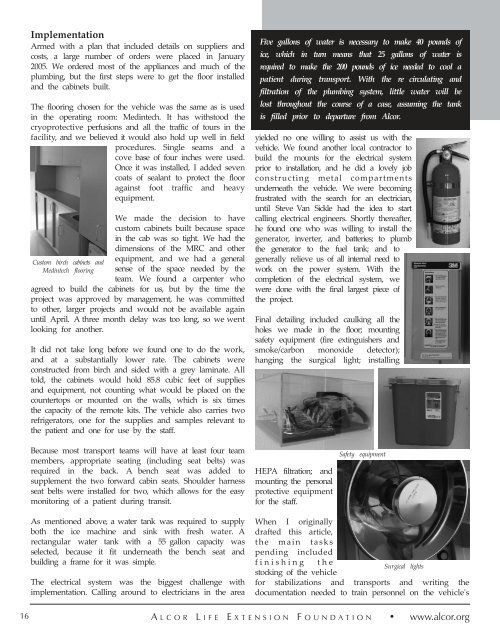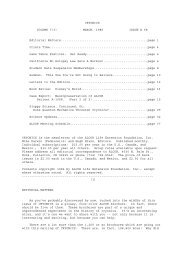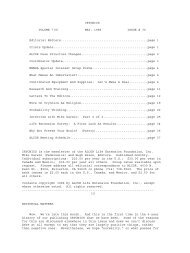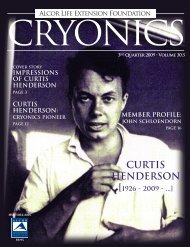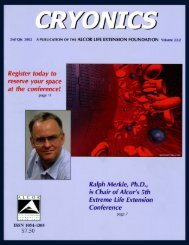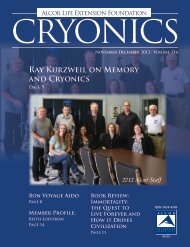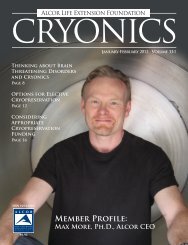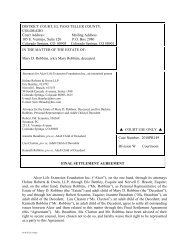Download PDF - Alcor Life Extension Foundation
Download PDF - Alcor Life Extension Foundation
Download PDF - Alcor Life Extension Foundation
You also want an ePaper? Increase the reach of your titles
YUMPU automatically turns print PDFs into web optimized ePapers that Google loves.
Implementation<br />
Armed with a plan that included details on suppliers and<br />
costs, a large number of orders were placed in January<br />
2005. We ordered most of the appliances and much of the<br />
plumbing, but the first steps were to get the floor installed<br />
and the cabinets built.<br />
The flooring chosen for the vehicle was the same as is used<br />
in the operating room: Medintech. It has withstood the<br />
cryoprotective perfusions and all the traffic of tours in the<br />
facility, and we believed it would also hold up well in field<br />
procedures. Single seams and a<br />
cove base of four inches were used.<br />
Once it was installed, I added seven<br />
coats of sealant to protect the floor<br />
against foot traffic and heavy<br />
equipment.<br />
Custom birch cabinets and<br />
Medintech flooring<br />
We made the decision to have<br />
custom cabinets built because space<br />
in the cab was so tight. We had the<br />
dimensions of the MRC and other<br />
equipment, and we had a general<br />
sense of the space needed by the<br />
team. We found a carpenter who<br />
agreed to build the cabinets for us, but by the time the<br />
project was approved by management, he was committed<br />
to other, larger projects and would not be available again<br />
until April. A three month delay was too long, so we went<br />
looking for another.<br />
It did not take long before we found one to do the work,<br />
and at a substantially lower rate. The cabinets were<br />
constructed from birch and sided with a grey laminate. All<br />
told, the cabinets would hold 85.8 cubic feet of supplies<br />
and equipment, not counting what would be placed on the<br />
countertops or mounted on the walls, which is six times<br />
the capacity of the remote kits. The vehicle also carries two<br />
refrigerators, one for the supplies and samples relevant to<br />
the patient and one for use by the staff.<br />
Because most transport teams will have at least four team<br />
members, appropriate seating (including seat belts) was<br />
required in the back. A bench seat was added to<br />
supplement the two forward cabin seats. Shoulder harness<br />
seat belts were installed for two, which allows for the easy<br />
monitoring of a patient during transit.<br />
As mentioned above, a water tank was required to supply<br />
both the ice machine and sink with fresh water. A<br />
rectangular water tank with a 55 gallon capacity was<br />
selected, because it fit underneath the bench seat and<br />
building a frame for it was simple.<br />
The electrical system was the biggest challenge with<br />
implementation. Calling around to electricians in the area<br />
Five gallons of water is necessary to make 40 pounds of<br />
ice, which in turn means that 25 gallons of water is<br />
required to make the 200 pounds of ice needed to cool a<br />
patient during transport. With the re circulating and<br />
filtration of the plumbing system, little water will be<br />
lost throughout the course of a case, assuming the tank<br />
is filled prior to departure from <strong>Alcor</strong>.<br />
yielded no one willing to assist us with the<br />
vehicle. We found another local contractor to<br />
build the mounts for the electrical system<br />
prior to installation, and he did a lovely job<br />
constructing metal compartments<br />
underneath the vehicle. We were becoming<br />
frustrated with the search for an electrician,<br />
until Steve Van Sickle had the idea to start<br />
calling electrical engineers. Shortly thereafter,<br />
he found one who was willing to install the<br />
generator, inverter, and batteries; to plumb<br />
the generator to the fuel tank; and to<br />
generally relieve us of all internal need to<br />
work on the power system. With the<br />
completion of the electrical system, we<br />
were done with the final largest piece of<br />
the project.<br />
Final detailing included caulking all the<br />
holes we made in the floor; mounting<br />
safety equipment (fire extinguishers and<br />
smoke/carbon monoxide detector);<br />
hanging the surgical light; installing<br />
HEPA filtration; and<br />
mounting the personal<br />
protective equipment<br />
for the staff.<br />
Safety equipment<br />
When I originally<br />
drafted this article,<br />
the main tasks<br />
pending included<br />
finishing the<br />
stocking of the vehicle<br />
Surgical lights<br />
for stabilizations and transports and writing the<br />
documentation needed to train personnel on the vehicle's<br />
16 A LCOR L IFE E XTENSION F OUNDATION • www.alcor.org


